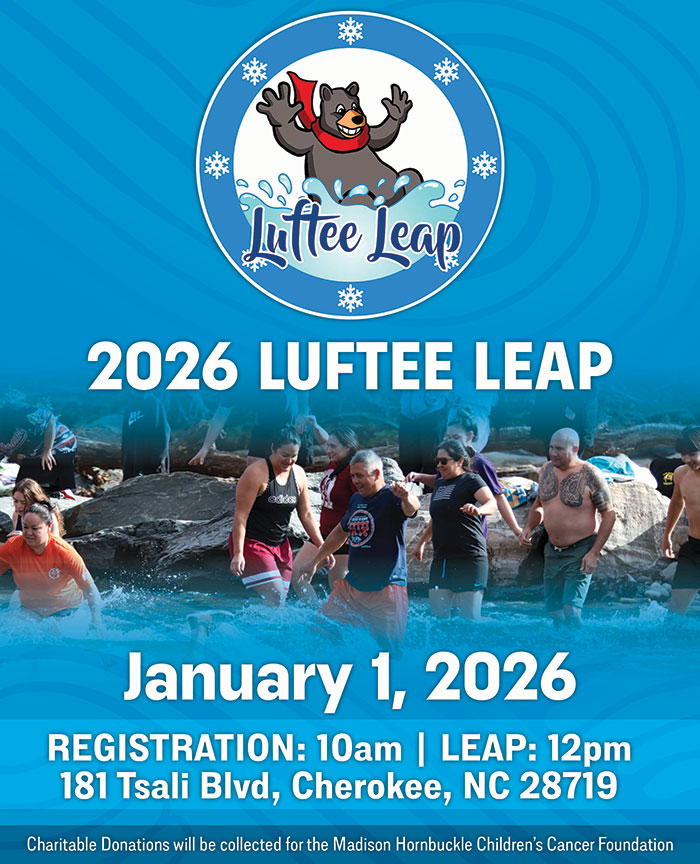By ROBERT JUMPER
Tutiyi (Snowbird) and Clyde, N.C.
At the risk of beating a dead horse, we have got to do something about our traffic, both vehicular and pedestrian. The way I see it, most of our worries come from a lack of both manpower and technology.
Just like most of you, I look at these things from outside the law enforcement community. I am just a common Joe who commutes to and from work five or six days a week and takes the occasional walk around parts of the Qualla Boundary. And when you do that on a regular basis, you see things. And you see things that are not pretty, literally and figuratively.
I have great respect for the tribal law enforcement community. The officers have a daunting task, as do the Courts and the Office of the Tribal Prosecutor. We commonly see these three entities in unison, because they are all part of the enforcement process. When we are suspected of doing something against the law, each department has a distinct part in the process, and each has its role and authority in the process.
Our Cherokee Indian Police Department (CIPD) has a role that includes identifying, charging, citing, and possibly detaining those who are suspected of committing crimes. The Prosecutor’s Office has the duty of determining whether adequate evidence is available and bringing the cases before a judge for adjudication. The Court is the determiner of guilt and consequences. And then the CIPD continues with its enforcement role via monitoring and detention. Each area has its own authority and processes. CIPD reports to the Chief of Police and the Police Commission. The Prosecutor’s Office is a subdivision of the Office of the Attorney General. The Court is a quasi-branch of government (Judicial), similar to the Dinilawigi (Tribal Council-Legislative) and the Ugvwiyuhi/Taline Ugvwiyu (Principal Chief/Vice Chief’s offices-Executive). The Court follows the provisions outlined in the Cherokee Code but makes decisions autonomously.
I know this is a super simple view of these offices and processes, and it definitely comes from a spectator perspective. Each of these entities has a very complex and serious responsibility. They learn mountains of information to enforce, prosecute, and execute judgment in law. Unfortunately, if we were to try to calculate the number of violations of tribal law on a daily basis, the numbers would stagger us. And those suspected violations that make it into the justice system are so numerous that we have a multi-month backlog of cases to be adjudicated. The workload and workforce of our justice system is strained and that is not a good thing.
Our leadership in these areas could be the best in the world, but if they do not have the resources that they need to execute their missions, their efforts are in jeopardy. You can have the best staff in the world, but if you put more on them than they may sustain, even the best staff members will burn out and give up on their missions. And we cannot afford to have that happen in our CIPD, Prosecutor’s Office, and the Court. Each function in the law enforcement realm needs to be at peak performance and capacity to ensure the safety of our people.
Back to the pedestrian/vehicle issue, which I believe is a symptom of an overstretched system. I have little doubt that our CIPD is hard at work fulfilling their responsibilities to make our community safe. But they cannot be everywhere all the time. And that leaves us with limited options when it comes to enforcement of things like traffic laws.
My ongoing example is traffic in the Cherokee Business District, particularly at the Casino and downtown. As I said, I commute at least five days each week and drive downtown Cherokee routinely, as most locals do. The speed limit is clearly marked at 20 mph. Every day of the week that I travel this route, I see drivers blow through our town way beyond that limit, and they aren’t doing the mystical five to ten miles over the limit that many presume is the “grace area” that law enforcement allows. The truth is that a grace limit is not a standard practice of any law enforcement agency. No, these folks hit 40 and 50 mph going through our town. Considering we have four or five pedestrian crosswalks in the downtown, people in those crosswalks become target practice for those drivers going those speeds.
Then there are the stretches of Soco Road leading into the Business District. That road is marked 45 mph and is a primarily residential area with roadside stickball games, children playing, and unleashed pets wandering across the road from time to time. Since there is a long straightaway through that residential area, it is marked for passing. Well, some folks ignore or neglect the posted speed limit, I guess assuming that if there is a passing lane that any speed is allowable. It’s not. But that doesn’t stop those “superior” drivers from blowing through at breakneck speeds, some topping 80 mph on that stretch. And if there happens to be a car in the opposing lane, the tension and drama increases. The “superior” drivers will A) play a game of chicken with the oncoming traffic in order to advance one or two car lengths or B) reenact a scene from a WWII war movie (tailgating and swooping back and forth on the vehicle in front of them, hoping to intimidate the lead driver to pull out of their way to let them pass or accelerate to an acceptable speed for the “tail gunner”). All of these behaviors, in addition to being sociopathic, are against the law (speeding, tailgating, and unsafe passing). But these “superior” drivers work on the premise that if an officer doesn’t see it, then it isn’t a violation. It doesn’t matter to them that they are putting lives in danger and surely doesn’t matter that it is against a law that was put in place with the intent of making travel safe for all. They just know that they want to get from point A to point B and no one will stand in their way of getting there an extra two minutes early.
And before you say, “Those darn tourists just don’t care about us”, the vast majority of those I see committing these violations have tribal vanity tags on their vehicles (you know, the one only tribal members may get from the DMV) or have some EBCI identifying marking on their door panels. I have seen the enemy, and it is us. Surely some of those violators are out-of-towners, but we do it the most.
A word about pedestrian crosswalks. The crosswalks in the downtown area are not the most visibly marked but they are noticeable for anyone looking to cross the four lanes of traffic downtown. After years of requests, highly visible crosswalks have been installed in the Casino area (I believe 4 or 5 of them). Without fail, I will watch pedestrians walk between crosswalks instead of going to a marked crosswalk to get to the other side. This is particularly amazing at the crossings from the parking lot on the Fairfield Inn side of the road to the Casino property. Folks will have marked flashing crosswalks 10 to 20 feet to either side of them, and they will choose to step across the street between those crosswalks because it is “more convenient” to where they parked versus their destination. Before those designated crosswalks were installed, that is how at least one young woman got killed, hit by a car while crossing the street in an unmarked area.
In the most recent traffic court docket that the One Feather received, there were 174 charged cases to be resolved. 174. For one court session. I like to try to drop into court sessions to keep my feet wet on how the system operates and this week I noted that there were 80 charged cases in criminal court to be heard in that two-day session. When you suspect that something is diseased, you look for symptoms. Now, if I believe that our police, prosecutors, and courts are doing all that they can to curb bad behavior and make our community safe, then I have to assume that they do not have the workforce or work tools needed to accomplish that task, based on observing those “superior” drivers and the large and backlogged courtroom at our Justice Center. As one of my colleagues is fond of saying, it is “simple math”. When I see a patrol car in the downtown, as I did yesterday, and blue lights are flashing and an officer is having a discussion with a motorist, I know that he or she is trying to get the job done. But while they are addressing one motorist, and several are passing in violation without anyone to address them while they take care of the one, it is obvious to me that the issue is not in the existing officers, but in the officers and resources that we do not have.
It is budget season in tribal government. Encourage your leaders to ask the leaders and staffing decision-makers in these areas for an accounting as to why they may have shortfalls in staffing and to give a realistic request for the personnel needed to ensure public safety, whether that be in the CIPD, Office of the Tribal Prosecutor, or the Court. There are viable solutions to situations like speeding downtown. Traffic cams and software programs are in use today, in smaller municipalities than ours, that will capture the license plate of a violator, be it a speeder, someone who blows past a stop signal, or a stopped school bus. That system will issue citations and mail those out to the owners of the violating vehicles. How about we put stuff like that up for budget consideration?
While former Ugvwiyuhi Patrick Lambert was in office, one of his first acts was to set up a reporting mechanism for tribal vehicles with the bumper of each tribally operated vehicle tagged with a toll-free phone number for the community to report driving violations. All tribal vehicles were required to be tagged with this number. Tips could be given anonymously. The phone number was simply tagged with “How’s my driving?” which invited us to give comments on tribal vehicle driver behavior, both good and bad. This seems to be a practical and relevant way to help address the ongoing issues we have with public safety.
Again, this is one symptom of a broad issue for our tribe. Thank you to those who serve in law enforcement. We need you. We care and want to support you. And whether you are in the police force, part of the prosecution team, or a servant through the tribal court, I think you need the workforce and resources to do your job effectively. This is something we cannot afford to do part way. Lives depend on it.





